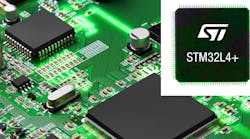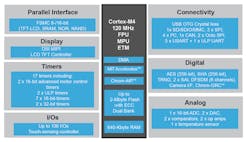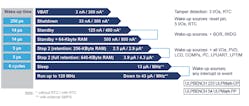Being a microcontroller these days can be rather tough. It’s hard to mix low power and high performance together, which generally means that large memories are needed for the latest applications. With its STM32L4+ family of ultra-low-power (ULP) microcontrollers (Fig. 1), STMicroelectonics (ST) looks to make good on meeting both of those goals.
1. The STM32L4+ family packs up to 2 MB of flash with ECC support into two banks, along with 640 kB of SRAM.
The 120-MHz STM32L4+ family delivers up to 410 EEMBC ULPMarks. The chips support over half a dozen power modes (Fig. 2). They can use as little as 43 µA when running at full speed, but significantly less when powered down. The modes allow developers to select what peripherals and memory need to be maintained while trading off wakeup time. There’s also a choice of wakeup sources.
The chips feature ST’s Adaptive Real-Time (ART) Accelerator, which is a cache front end for up to 2 MB of flash memory with ECC support. They integrate a large 640-kB SRAM as well. The system can access parallel off-chip flash storage as well as 60-Mb/s QSPI or 86-MHz OctoSPI.
Communication support includes UARTs that run up to 10 Mb/s. Also in the mix is a ULP UART, crystal-less USB OTG, CAN, I2C, SPI, and SDIO. On the analog side, the system supports a 16-bit analog-to-digital converter (ADC), two digital-to-analog converters (DACs), two comparators, and two op amps. There’s an on-chip temperature sensor, too.
2. The STM32L4+ supports over half a dozen power modes to help minimize power requirements.
The 2D graphics support is enhanced by ST’s Chroma-ART. It provides hardware graphics acceleration that includes support for anti-aliased fonts as well as plane blending and pixel format conversion. This support offloads the Cortex-M4F CPU. The family also maintains a range of display interfaces, such as MIPI-DSI for high-density, low-pin-count and low-EMI displays, LCD-TFT, and parallel display interfaces for low-resolution displays. MIPI-DSI displays can range up to 400 by 400, 24-bit pixels. LCD-TFT displays up to four inches with WQVGA at 16 bits/pixel. The 640-kB SRAM also pays off for display handling, since external storage isn’t required.
ST provides free development tools, in addition to the STM32CubeL4 drivers and middleware. This includes USB drivers, FreeRTOS, an open-source FAT file system, and the STemWin graphical library from ST and Segger.
Chips are housed in packages as small as 5.2 by 5.2 mm.



